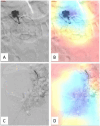Artificial Intelligence for Identification of Images with Active Bleeding in Mesenteric and Celiac Arteries Angiography
- PMID: 38530394
- PMCID: PMC11164777
- DOI: 10.1007/s00270-024-03689-x
Artificial Intelligence for Identification of Images with Active Bleeding in Mesenteric and Celiac Arteries Angiography
Abstract
Purpose: The purpose of this study is to evaluate the efficacy of an artificial intelligence (AI) model designed to identify active bleeding in digital subtraction angiography images for upper gastrointestinal bleeding.
Methods: Angiographic images were retrospectively collected from mesenteric and celiac artery embolization procedures performed between 2018 and 2022. This dataset included images showing both active bleeding and non-bleeding phases from the same patients. The images were labeled as normal versus images that contain active bleeding. A convolutional neural network was trained and validated to automatically classify the images. Algorithm performance was tested in terms of area under the curve, accuracy, sensitivity, specificity, F1 score, positive and negative predictive value.
Results: The dataset included 587 pre-labeled images from 142 patients. Of these, 302 were labeled as normal angiogram and 285 as containing active bleeding. The model's performance on the validation cohort was area under the curve 85.0 ± 10.9% (standard deviation) and average classification accuracy 77.43 ± 4.9%. For Youden's index cutoff, sensitivity and specificity were 85.4 ± 9.4% and 81.2 ± 8.6%, respectively.
Conclusion: In this study, we explored the application of AI in mesenteric and celiac artery angiography for detecting active bleeding. The results of this study show the potential of an AI-based algorithm to accurately classify images with active bleeding. Further studies using a larger dataset are needed to improve accuracy and allow segmentation of the bleeding.
Keywords: Artificial intelligence; Convolutional neural networks; Gastrointestinal bleeding; Interventional radiology.
© 2024. The Author(s).
Conflict of interest statement
The authors declare that they have no conflict of interest.
Figures



References
MeSH terms
LinkOut - more resources
Full Text Sources
Medical

